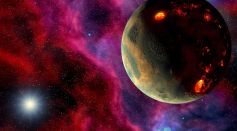SPACE

How Artificial Intelligence (AI) Makes Astronomy Faster, More Powerful?
Understanding Energy Production in Stars: Scientists Investigate Muon Capture in Hydrogen Isotope

When Did Pluto Stop Being a Planet? Why Was It Reclassified and Demoted?
Mercury, Smallest Planet in the Solar System, Is Still Shrinking and Getting More Wrinkles
JWST Discovers Dozens of Planet-Like Objects Untethered to Any Star in Trapezium Cluster

NASA's Reimagined New Horizons Mission Will Now Explore the Sun's Influence at the Solar System's Edge
Crashing Neutron Stars Could Solve the Hubble Trouble, Provide Clue in Measuring the Expansion of the Universe
SpaceX Conducts Static Fire Test on Falcon Heavy at NASA’s Kennedy Space Center Ahead Psyche Asteroid Mission Launch
SpaceX Receives $70 Million in First Contract With Space Force for Starshield Military Satellites
BlueWalker 3 Satellite Now One of the Brightest Objects in the Night Sky, Signaling Low-Earth Orbit's Brightening Crisis

James Webb Space Telescope Finds Numerous Starless Jupiter-Sized Planets in New Orion Nebula Survey
Faster Than Speed of Light: Can Tachyon Really Travel Back in Time?
India’s Spacecraft Aditya-L1 Escapes Sphere of Earth’s Influence, ISRO Says

Nearly 50% of Rocky Exoplanets Revealed as 'Burning Worlds' with Lava Oceans: Study Explores Their Impact on Super-Earths
Most Popular

Largest Known Volcanic Aquifer Discovered Beneath Oregon's Cascades

New 'Supergiant' Sea Bug Found in South China Sea, Named After Darth Vader

Mediterranean Sea Was Refilled by a Catastrophic Flood Millions of Years Ago

Mysterious Cosmic Waves That Sound Like Birds Detected in Unexpected Space Region




